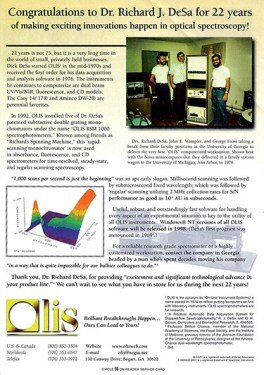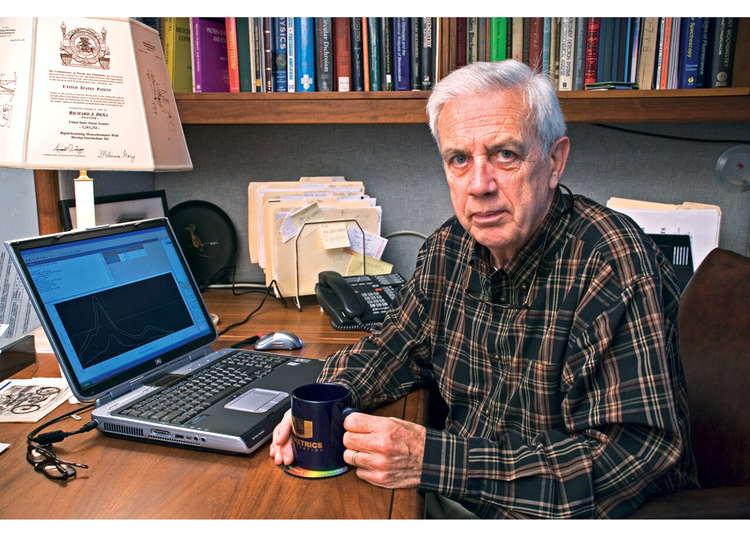Spectrophotometers Things To Know Before You Buy
Table of ContentsGet This Report on Circularly Polarized LuminescenceAn Unbiased View of Uv/vis/nirFascination About Circular Dichroism6 Simple Techniques For Circularly Polarized LuminescenceAll about SpectrophotometersThe Ultimate Guide To Circular DichroismCircularly Polarized Luminescence for DummiesCircular Dichroism for BeginnersSpectrophotometers - An OverviewThe Best Guide To Circularly Polarized LuminescenceSome Known Questions About Uv/vis.5 Easy Facts About Circularly Polarized Luminescence Shown5 Easy Facts About Circularly Polarized Luminescence Described
It is then scanned through the sample and the referral options. Portions of the incident wavelengths are transmitted through, or reflected from, the sample and the referral. The resultant light strikes the photodetector device, which compares the relative intensity of the 2 beams. Electronic circuits transform the relative currents into direct transmission portions and/or absorbance/concentration worths.The transmission of a referral compound is set as a standard (information) value, so the transmission of all other substances are recorded relative to the initial "zeroed" substance. The spectrophotometer then transforms the transmission ratio into 'absorbency', the concentration of specific parts of the test sample relative to the preliminary substance.
Since samples in these applications are not easily offered in big quantities, they are especially suited to being examined in this non-destructive technique. In addition, precious sample can be saved by using a micro-volume platform where just 1u, L of sample is required for total analyses. A brief description of the treatment of spectrophotometry consists of comparing the absorbency of a blank sample that does not contain a colored substance to a sample which contains a colored substance.
Uv/vis Things To Know Before You Buy
In biochemical experiments, a chemical and/or physical property is picked and the treatment that is used specifies to that residential or commercial property in order to obtain more information about the sample, such as the quantity, pureness, enzyme activity, and so on. Spectrophotometry can be used for a variety of methods such as determining ideal wavelength absorbance of samples, determining optimal p, H for absorbance of samples, identifying concentrations of unknown samples, and figuring out the p, Ka of different samples.: 21119 Spectrophotometry is also a handy process for protein filtration and can also be utilized as a method to develop optical assays of a compound.
It is possible to know the concentrations of a two element mixture using the absorption spectra of the standard services of each component. To do this, it is needed to understand the extinction coefficient of this mixture at 2 wave lengths and the termination coefficients of services which contain the known weights of the two elements.

Uv/vis for Beginners
Region. The concentration of a protein can be estimated by measuring the OD at 280 nm due to the presence of tryptophan, tyrosine and phenylalanine.
This technique needs a spectrophotometer capable of determining in the UV area with quartz cuvettes.: 135 Ultraviolet-visible (UV-vis) spectroscopy involves energy levels that thrill electronic transitions. Absorption of UV-vis light delights particles that are in ground-states to their excited-states.
These curves can be utilized to evaluate a brand-new batch of colorant to examine if it makes a match to specifications, e
Traditional visible standard spectrophotometers area not detect if a colorant or the base material has product. This can make it difficult to handle color concerns if for example one or more of the printing inks is fluorescent. There are 2 significant setups for visual spectrum spectrophotometers, d/8 (round) and 0/45.
Scientists use this instrument to measure the amount of compounds in a sample. If the compound is more concentrated more light will be taken in by the sample; within little varieties, the Beer, Lambert law holds and the absorbance in between samples differ with concentration linearly. In the case of printing measurements 2 alternative settings are frequently utilized- without/with uv filter to control better the effect of uv brighteners within the paper stock.
The smart Trick of Uv/vis That Nobody is Talking About
Some applications require small volume measurements which hop over to these guys can be carried out with micro-volume platforms. As described in the applications section, spectrophotometry can be used in both qualitative and quantitative analysis of DNA, RNA, and proteins. Qualitative analysis can be used and spectrophotometers are utilized to tape spectra of compounds by scanning broad wavelength regions to figure out the absorbance properties (the intensity of the color) of the compound at each wavelength.

The Ultimate Guide To Uv/vis
One significant aspect is the type of photosensors that are available for various spectral areas, however infrared measurement is likewise difficult because virtually everything emits IR as thermal radiation, particularly at wavelengths beyond about 5 m. Another problem is that rather a couple of materials such as glass and plastic soak up infrared, making it incompatible as an optical medium.
Retrieved Dec 23, 2018. Fundamental Lab Techniques for Biochemistry and Biotechnology (2nd ed.). The vital guide to analytical chemistry.
Oke, J. B.; Gunn, J. E.
The smart Trick of Circularly Polarized Luminescence That Nobody is Discussing

Ninfa AJ, Ballou DP, Benore M (2015 ). Essential Laboratory Techniques for Biochemistry and Biotechnology (3, rev. ed.). circular dichroism. Lab Devices.
The Ultimate Guide To Circularly Polarized Luminescence
"Applied Spectrophotometry: Analysis of a Biochemical Mixture". Biochemistry and Molecular Biology Education. Journal of Biochemistry Education.
Excitement About Uv/vis/nir
U.S. Department of Commerce National Bureau of Standards unique publication; 378. Washington, D.C.: U.S. National Bureau of Standards. p. 2. OCLC 920079.
The procedure starts with a controlled light that brightens the evaluated sample. When it comes to reflection, as this light interacts with the sample, some is soaked up or released. The emitted light travels to the detector, which is examined, measured, and presented as industry-standard color scales and indices.
All terms are evaluated over the noticeable spectrum from 400 to 700 nm. In the case of transmission, when the light connects with the sample, it is either soaked up, shown, or transmitted.
A Biased View of Uv/vis/nir
Examples consist of APHA (American Public Health Association) for watercolor and pureness analysis, ASTM D1500 for petrochemical color analysis, edible oil indices used in food, and color analyses of drinks. The streamlined math looks like this:. Where T is the transmission coefficient. All terms are evaluated over the visible spectrum from 400 to 700 nm.
Image Credit: Matej Kastelic/ Dr. Arnold J. Beckman and his colleagues at the National Technologies Laboratories initially created the spectrophotometer in 1940. In 1935 Beckman founded the business, and the discovery of the spectrophotometer was their most ground-breaking invention. Dr. Bruce Merrifield, a Nobel prize-winning biochemist, mentioned that the innovation of the spectrophotometer was "most likely the most crucial instrument ever established towards the improvement of bioscience." Before the discovery of the spectrophotometer, chemical analyses took weeks to complete, with 25% precision.
Uv/vis for Dummies
99% precision. Gradually, scientists kept enhancing the spectrophotometer design to enhance its efficiency. The UV abilities of the design B spectrophotometer were improved by changing the glass prism with a quartz prism. Eventually, the Model DU was created, containing a hydrogen light and other improvements. This instrument was used in commercial laboratories, centers, and chemistry and biochemistry departments.
After 1984, double-beam variations of the gadget were developed. The addition of external software application with the arrangement of onscreen screens of the spectra was available in the 1990s. Typically, a spectrophotometer is comprised of 2 instruments, specifically, a spectrometer and a photometer. A standard spectrophotometer consists of a light, a monochromator, a collimator for straight light beam transmission, a cuvette to put a sample, and a photoelectric detector.
Spectrophotometers - Questions
There are various types of spectrophotometers in various shapes and sizes, each with its own function or functionality. A spectrophotometer figures out just how much light is reflected by chemical parts. UV/Vis. It measures the difference in light strength based upon the total amount of light presented to a sample and the amount of light beam that passes through the sample solution
Based on the instrument's design, the sample is put between the spectrometer and the photometer. After the light is travelled through the sample, the photometer determines its intensity and displays the reading. A spectrophotometer is utilized to determine the concentration of both colorless and colored solutes in a service. This instrument is used to figure out the rate of a response.